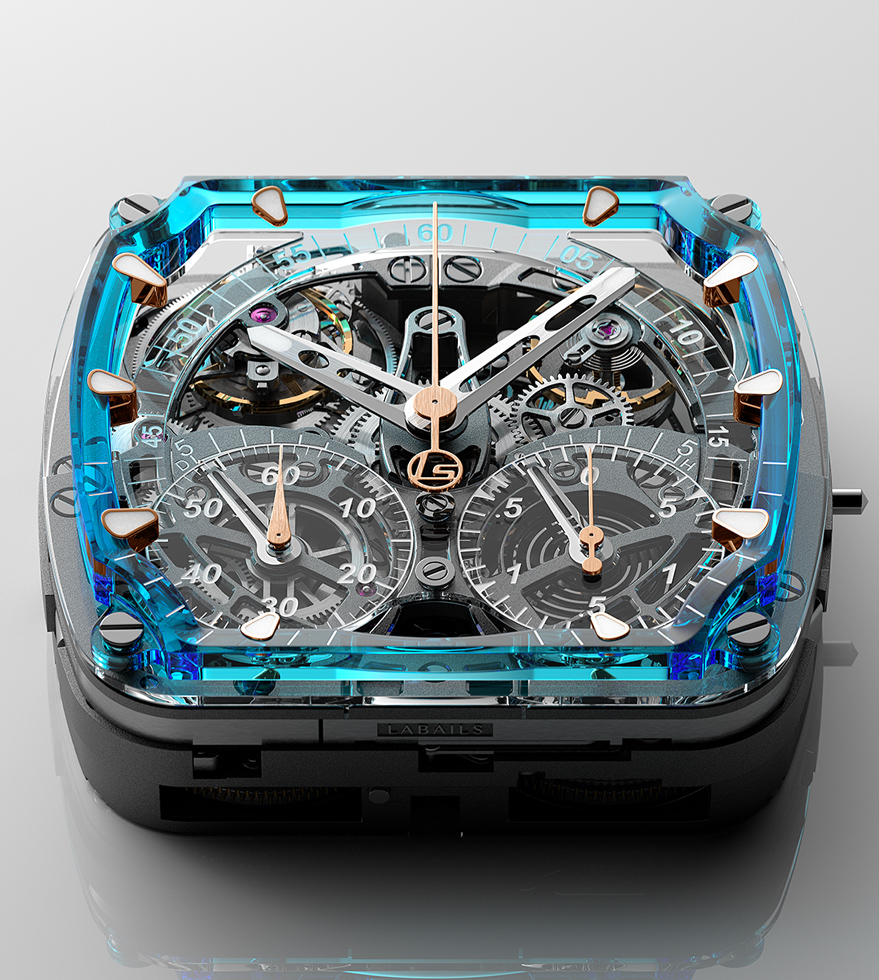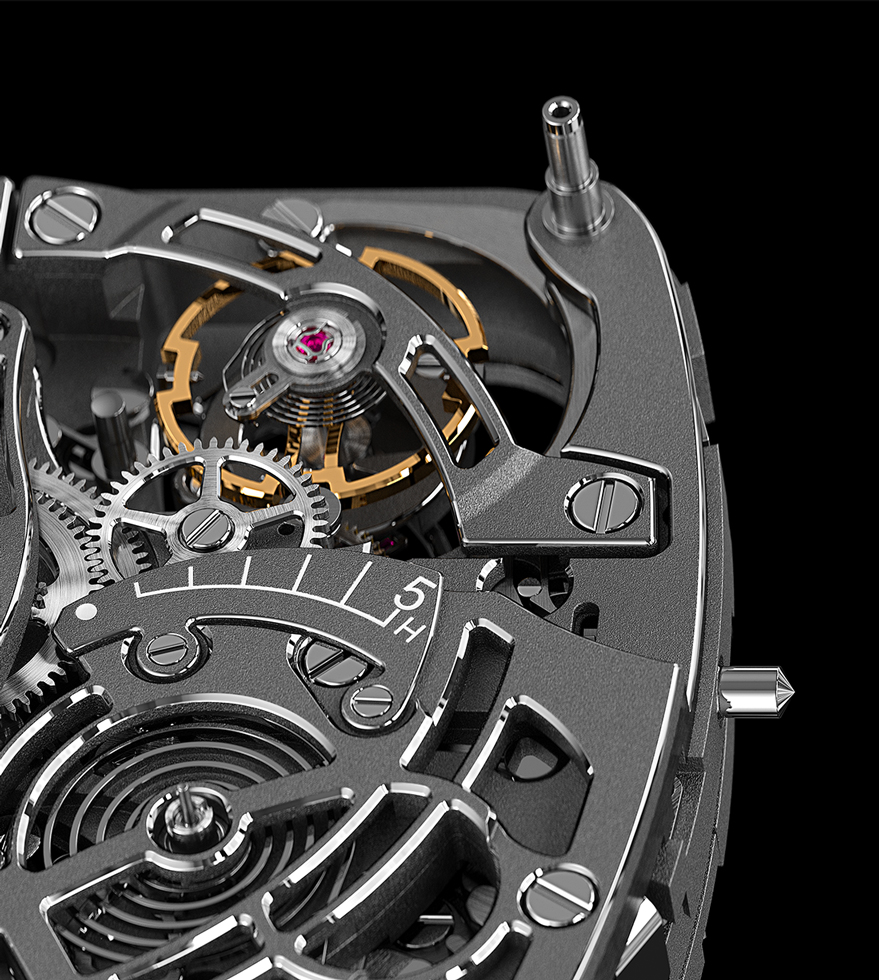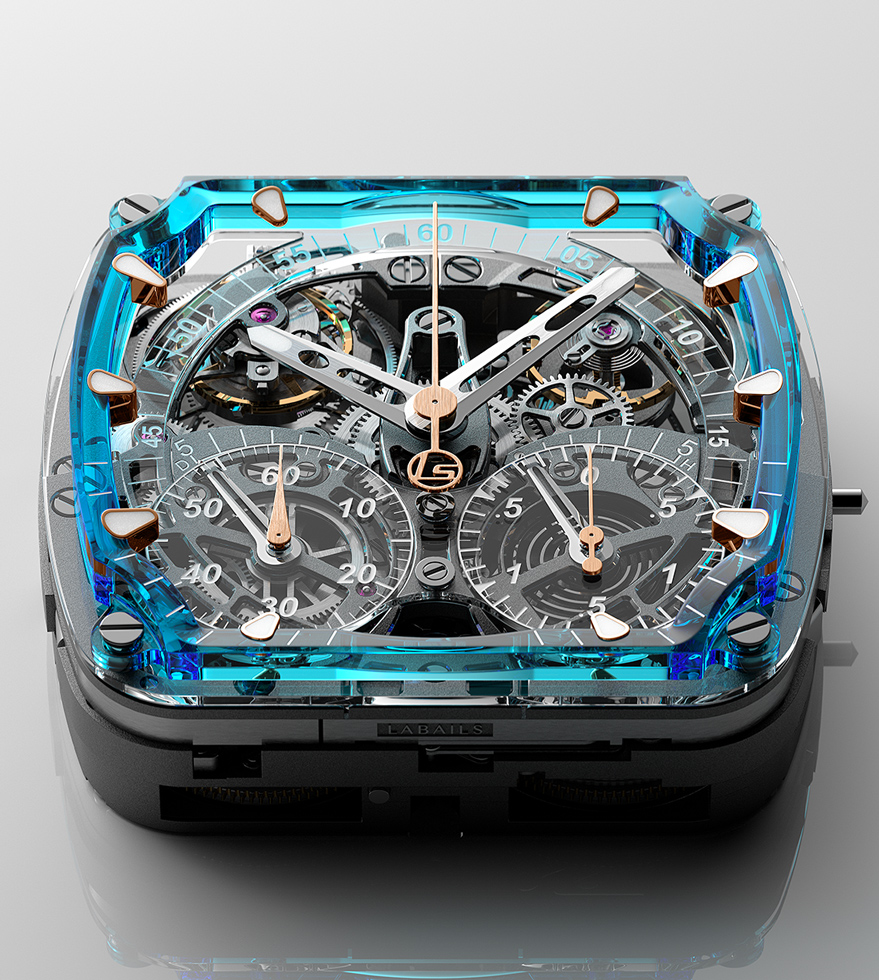ENGINEERING
EMOTIONS
ENGINEERING
EMOTIONS
CONCEPT
When we start from a blank page, the great advantage is being able to do everything we want. We developed Temerity as a sports watch and what is a better complication for a sports watch than a chronograph?
In the case of Temerity, we wanted a tourbillon chronograph.
But we wanted our chronograph to be special. We wanted it to be able to time events with a fine measurement without suffering from the high-frequency defects.
High-frequency, crucial for a fine measurement, impacts severely the energy consumption and can have a long-term impact on the precision of the primary function. The usual solution to the problem is to create two distinct kinematic chains, one for the primary function, one for the chronograph. This does not only result in a loss of useful space in a highly limited volume but, more importantly, also in a loss of useful energy because in such an architecture, one energy source is permanently dedicated to a secondary function which is occasionally used.
Therefore, an optimized solution had to be found and we found it. We created a unique architecture focused on energy management with two kinematic chains in one: the primary one dedicated to the hours-minutes function and the secondary one, optional, dedicated to a high-frequency chronograph. This architecture is managed via an exclusive and innovative Energy Management Optimization System developed by LABAILS.
THE PRIMARY FUNCTION
The primary function of the watch is to display hours and minutes.
To ensure this function, Temerity regulates it via a 3Hz escapement and balance-wheel system embedded in a 60-seconds Tourbillon.
This choice optimizes the power reserve (low-frequency oscillations) and limits the negative effects of the gravity on the isochronism of the function.
In order to prevent possible inertia disparities during the calibration of the regulator, we call for a variable-inertia balance-wheel equipped with 4 adjustment screws.
The stop-second mechanism added to the 60-seconds-Tourbillon’s cage allows the user to accurately adjust the time with a marker embedded on the cage.

THE FIVE-HUNDREDTHS OF-A-SECOND CHRONOGRAPH
The measurement of short times always has been a challenge for mechanical horology.
The choice to dedicate a high-frequency regulator with a 10Hz balance-wheel to this function allows Temerity to time events whose duration of up to 5 hours with a display accuracy of 5hundredths of a second.
The 10 Hz-regulator fully oscillates 10 times per second, it means the escapement wheel changes position 20 times per second (72’000 times per hour); in other words, it changes position every 5-hundredths-of-a-second.
In order to prevent possible inertia disparities during the calibration of the regulator, we use a variable-inertia balance-wheel equipped with 4 adjustment screws.

In order to facilitate reading the measurement, three hands are positioned on three separate dials: one for the jumping minutes, one for the seconds and one for the 5 hundredths of a second. This latter is divided into three one-second segments, therefore the 5-hundredths-of-a-second hand rotates at an angular speed of 120° per second, the perfect compromise, at this frequency, between speed, fluidity of motion and readability.
In order to reach this rotation speed, the hands of the chronograph are made of aluminum. This extremely lightweight metal, which has a density of only 2,7 g/cm3, allows us to optimize the torque-rotation speed relationship by reducing the inertia of the hands.
The pitch of the 5-hundredths-of-a-second hand is directly controlled by the high-frequency regulator, consequently it is the finest duration measurable with Temerity.
The chronograph function is controlled by two push buttons: Start/stop & Reset. When started, the vertical clutch system (controlled by a column wheel) of the chronograph allows the hands to be driven with a better precision, to ensure a perfect start.

THE PRIMARY FUNCTION
The primary function of the watch is to display hours and minutes.
To ensure this function, Temerity regulates it via a 3Hz escapement and balance-wheel system embedded in a 60-seconds Tourbillon.
This choice optimizes the power reserve (low-frequency oscillations) and limits the negative effects of the gravity on the isochronism of the function.
In order to prevent possible inertia disparities during the calibration of the regulator, we call for a variable-inertia balance-wheel equipped with 4 adjustment screws.
The stop-second mechanism added to the 60-seconds-Tourbillon’s cage allows the user to accurately adjust the time with a marker embedded on the cage.

THE FIVE-HUNDREDTHS-OF-A-SECOND CHRONOGRAPH

The measurement of short times always has been a challenge for mechanical horology.
The choice to dedicate a high-frequency regulator with a 10Hz balance-wheel to this function allows Temerity to time events whose duration of up to 5 hours with a display accuracy of 5hundredths of a second.
The 10 Hz-regulator fully oscillates 10 times per second, it means the escapement wheel changes position 20 times per second (72’000 times per hour); in other words, it changes position every 5-hundredths-of-a-second.
In order to prevent possible inertia disparities during the calibration of the regulator, we use a variable-inertia balance-wheel equipped with 4 adjustment screws.

In order to facilitate reading the measurement, three hands are positioned on three separate dials: one for the jumping minutes, one for the seconds and one for the 5 hundredths of a second. This latter is divided into three one-second segments, therefore the 5-hundredths-of-a-second hand rotates at an angular speed of 120° per second, the perfect compromise, at this frequency, between speed, fluidity of motion and readability.
In order to reach this rotation speed, the hands of the chronograph are made of aluminum. This extremely lightweight metal, which has a density of only 2,7 g/cm3, allows us to optimize the torque-rotation speed relationship by reducing the inertia of the hands.
The pitch of the 5-hundredths-of-a-second hand is directly controlled by the high-frequency regulator, consequently it is the finest duration measurable with Temerity.
The chronograph function is controlled by two push buttons: Start/stop & Reset. When started, the vertical clutch system (controlled by a column wheel) of the chronograph allows the hands to be driven with a better precision, to ensure a perfect start.
UP TO FIVE DAYS
OF POWER RESERVE
Despite a high-frequency chronograph function, its unique architecture focused on the energy management combined to two barrels allows the Temerity to offer up to 5 days of power reserve for the primary function.
This long power reserve is only possible thanks to the exclusive and patent-pending system developed by LABAILS called Energy Management Optimization System: EMOS.
EMOS, THE INNOVATIVE SYSTEM
The conceptual choice to dedicate a kinematic chain to a secondary function to increase the display accuracy is not new, especially for chronograph functions. However, for LABAILS, the choice to dedicate an energy source to this secondary function which will be used only punctually is a conceptual error.
The exclusive and innovative system developed by LABAILS, EMOS allows the user to manage how the main energy source is used via a gear switch at 9H, which proposes two modes:
The desynchronization between engaging the Sports mode and starting the chronograph was designed on purpose because essential. It gives the few tenths-of-a-second needed for the high-frequency balance wheel to reach its nominal oscillation regime and therefore gives the chronograph the ability to measure with its full accuracy as soon as it is started.
ADAPTIVE POWER RESERVE INDICATORS
In order to track the energy consumption of the two functions, Temerity embeds two distinct power reserve indicators.
The first one is dedicated to track the energy level of the primary function in real-time, whether in Eco or in Sports mode, meaning that this indicator will adapt its course depending on the use of the secondary function.
The second one is exclusively dedicated to the Sports mode and tracks the energy consumption of the high-frequency regulator. When in Eco mode, the high-frequency regulator is inactivated, therefore this indicator displays it.
Both of these power reserve indicators are powered by planetary differentials.

EMOS,
THE INNOVATIVE SYSTEM
The conceptual choice to dedicate a kinematic chain to a secondary function to increase the display accuracy is not new, especially for chronograph functions. However, for LABAILS, the choice to dedicate an energy source to this secondary function which will be used only punctually is a conceptual error.
The exclusive and innovative system developed by LABAILS, EMOS allows the user to manage how the main energy source is used via a gear switch at 9H, which proposes two modes:
Eco Mode
In Eco mode (energy saving mode), the energy source
is fully dedicated to the primary function.
The energy consumption is low.
The high-frequency kinematic chain is inactivated, therefore
the high-frequency balance wheel is motionless.
Sport Mode
In Sports mode, the energy source continues to supply the primary function but
also supplies the secondary function.
The high-frequency balance wheel is operating, allowing the user to use
the chronograph to time events.
The energy consumption in this mode is high so, in order to prevent the primary
function from stopping, when the remaining power reserve reaches 24 hours,
the high-frequency balance-wheel is automatically inhibited.
We call it the main power reserve safety system.
The desynchronization between engaging the Sports mode and starting the chronograph was designed on purpose because essential. It gives the few tenths-of-a-second needed for the high-frequency balance wheel to reach its nominal oscillation regime and therefore gives the chronograph the ability to measure with its full accuracy as soon as it is started.
The desynchronization between engaging the Sports mode and starting the chronograph is essential. It gives
the few tenths-of-a-second needed for the high-frequency balance wheel to reach its nominal oscillation regime
and therefore gives the chronograph the ability to measure with its full accuracy as soon as it is started.
ADAPTIVE POWER RESERVE INDICATORS
In order to track the energy consumption of the two functions, Temerity embeds two distinct power reserve indicators.
The first one is dedicated to track the energy level of the primary function in real-time, whether in Eco or in Sports mode, meaning that this indicator will adapt its course depending on the use of the secondary function.
The second one is exclusively dedicated to the Sports mode and tracks the energy consumption of the high-frequency regulator. When in Eco mode, the high-frequency regulator is inactivated, therefore this indicator displays it.
Both of these power reserve indicators are powered by planetary differentials.
TECHNICAL SPECIFICATIONS*
MOVEMENT
Architecture:
- Dimensions (L x w x h) : 32 x 36.25 x 11.6 mm
- Weight: 20,68g
- Number of parts: 551
- Tourbillon cage: 35 parts, 0.38g
- Number of jewels: 65; polished bevelling of housing bore
Hours & Minutes function:
- Regulating organ: 60-second Tourbillon with stop-second system, 3Hz regulating organ (21’600 alt/h; 8.30mm diameter; incabloc shock protection), variable-inertia balance-wheel with gold adjustment screws
- Hands: rhodium plated with Super-Luminova, chamfered, polished and satin-finished
- Rehaut: sky-blue yttrium aluminum garnet, polished
- Indexes: rose gold (18K) with Super-Luminova
Chronograph function:
- Regulating organ: High-frequency regulating organ (10Hz / 72’000 alt/h; 8mm diameter; incabloc shock protection) with two stop-second systems, variable-inertia balance-wheel with gold adjustment screws
- Chronograph function (start/stop/reset): three dials and three hands: jumping minutes, seconds, 0.05 seconds
- Dials: sapphire, polished, engraved, lacquered
- Hands: aluminum (density 2.7), rose gold plated, satin-finished
Energy Management:
- Energy source: two parallel barrels with slipping springs to avoid excess tension
- Manual winding
- Energy Management Optimization System with to modes: Eco & Sports
- Fast-rotating barrels: 1 turn in 24 minutes in Sports mode
- Power reserve: Up to 120 hours (full Eco mode)
- Chronograph power reserve: Up to 5 hours (full Sports mode)
- Two adaptive power reserve indicators
- Main power reserve safety system activated when 24 hours are remaining
- Titanium
- Microblasted, satin-finished, polished beveling, polished, polished wording inscriptions
Gearing:
- Involute circle profile
- Finishing: circular satin-finished, rhodium plated, polished beveling, polished
CASE
- Dimensions (L x w x h) : 51.95 x 48 x 16.8 mm
- Water resistance: 5 ATM
- Full sapphire case: polished, laser engravings
- Crown: rose gold (18K) and sapphire, polished, microblasted, laser engraved logo
- Push buttons and gear switch: rose gold (18K), polished, microblasted
- Sapphire glasses with anti-reflective treatment on both sides
STRAP
- Material: FKM
- Width: 20 mm
- Fixing inserts in titanium
- Pin buckle in rose gold (18K)
*These specifications are expected technical specifications. Final technical specifications will be communicated at a later stage.

